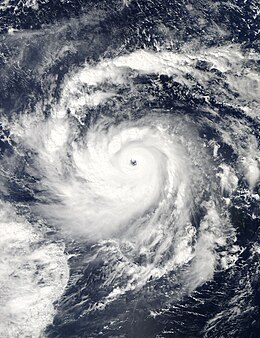Typhoon Nida (2009)
| Typhoon (JMA scale) | |
|---|---|
| Category 5 (Saffir–Simpson scale) | |

Typhoon Nida near peak intensity on November 25
|
|
| Formed | November 21, 2009 |
| Dissipated | December 3, 2009 |
| Highest winds |
10-minute sustained: 215 km/h (130 mph) 1-minute sustained: 285 km/h (180 mph) |
| Lowest pressure | 905 hPa (mbar); 26.72 inHg |
| Fatalities | None |
| Damage | None |
| Areas affected | Micronesia, Guam |
| Part of the 2009 Pacific typhoon season | |
Typhoon Nida, known in the Philippines as Tropical Storm Vinta, was the most intense tropical cyclone in the Northwest Pacific Ocean during the 2000s, tied with Jangmi in 2008.
Early on November 21 the Joint Typhoon Warning Center (JTWC) reported that an area of convection had persisted within a monsoon trough about 880 km, (545 mi) to the southeast of Guam. At this time the system was moving around the subtropical ridge of pressure, with an anticyclone over the cyclone helping the convection to consolidate over a broad and elongated low level circulation center which was located in an area of minimal vertical wind shear. Later that morning a Tropical Cyclone Formation Alert was released as deep convection increased in organization with multiple bands of convection starting to wrap into the developing low level circulation center. The system was then declared as a tropical depression by the JMA later that day before the JTWC followed suit early the next day, who assigned the designation of 26W to the depression. During November 22, the depression remained weak, before during the next day both the JMA and the JTWC upgraded the depression to a tropical storm, with the JMA assigning the international number of 0922 and name of Nida as it started to move along a subtropical ridge.
Later on November 23, microwave imagery showed that an eye had developed within a well defined low level circulation center. Early the next day, the JTWC reported that Nida had intensified into a category 1 typhoon as the eye became well defined with deep convection wrapping around most of the eye. However, despite the JTWC reporting 1-minute sustained wind speeds of 160 km/h, (100 mph), the JMA only reported 10-minute sustained wind speeds of 110 km/h, (70 mph) which made Nida a Severe Tropical Storm. Early on November 25 the JMA reported that Nida had intensified into a typhoon before reporting later that day that the typhoon had rapidly intensified under favourable conditions and reached its peak 10-minute wind speeds of 195 km/h (120 mph), with a peak pressure of 905 hPa. During the next day the JTWC also reported that Typhoon Nida had rapidly intensified over the previous 18 hours into a category five super typhoon with winds of 285 km/h (180 mph), as it maintained a well defined symmetrical structure. The JTWC then reported that Nida had intensified a little bit more and reached its peak 1-minute sustained wind speeds of 290 km/h (185 mph).
...
Wikipedia
